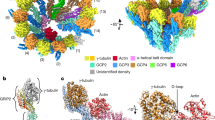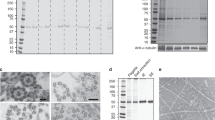Abstract
IT has been known for some time from electron microscopy that eukaryotic cells contain a fibrillar cytoskeleton. Recently, immunofluorescence has greatly advanced our understanding of how the cytoskeleton functions in controlling the shape and behaviour of cells1 by allowing immunological identification and by displaying the three-dimensional distribution of the constituent proteins. As plant cell walls exclude antibodies, such work has been carried out almost entirely on animal cells. It is not possible to extrapolate from animals to plants because the problems are not the same: plant microtubules occur in cortical hoops at right angles to the axis of cell elongation unlike, say, neuronal outgrowth; they overlap to form bundles; they do not appear to grow from focal points around the nucleus and they are conspicuously cross-bridged to each other and to the plasma membrane2. In a rare study on higher plant cells, Franke et al.3 made use of the immunological cross-reactivity between mammalian anti-tubulin and plant microtubules to study the giant mitotic apparatus in the endosperm of the March cup flower. However, such temporary nutritive tissue may have no significant wall deposition and although ideal for studying the nucleus is unsuitable for studying the cytoplasmic microtubules involved with cellulose in controlling plant cell shape. Franke et al.3 saw no cytoplasmic microtubules and for the study reported here we therefore used single, elongated cells from carrot suspension cultures which we know from electron microscopy (EM) studies (unpublished) to contain cytoplasmic microtubules. A controlled cellulase treatment and detergent extraction to allow the entry of antibodies to these cells was used, and we believe this to be the first report of the immunofluorescent staining of cytoplasmic microtubules in higher plant cells.
This is a preview of subscription content, access via your institution
Access options
Subscribe to this journal
Receive 51 print issues and online access
$199.00 per year
only $3.90 per issue
Buy this article
- Purchase on Springer Link
- Instant access to full article PDF
Prices may be subject to local taxes which are calculated during checkout
Similar content being viewed by others
References
Ash, J. F. & Singer, S. J. Proc. natn. Acad. Sci. U.S.A. 73, 4575–4579 (1976).
Hardham, A. R. & Gunning, B. E. S. J. Cell Biol. 77, 14–34 (1978).
Franke, W. W. et al. Cytobiologie 15, 24–48 (1977).
Heath, I. B. J. theor. Biol. 48, 445–449 (1974).
Badley, R. A. et al. Expl Cell Res. 117, 231–244 (1978).
Shelanski, M. L., Gaskin, F. & Cantor, C. R. Proc. natn. Acad. Sci. U.S.A. 70, 765–768 (1973).
Jokusch, B. M., Kelley, K. H. & Meyer, R. K. Histochem. 55, 177–184 (1978).
Author information
Authors and Affiliations
Rights and permissions
About this article
Cite this article
LLOYD, C., SLABAS, A., POWELL, A. et al. Cytoplasmic microtubules of higher plant cells visualised with anti-tubulin antibodies. Nature 279, 239–241 (1979). https://doi.org/10.1038/279239a0
Received:
Accepted:
Issue Date:
DOI: https://doi.org/10.1038/279239a0
This article is cited by
-
Visualisation of microtubules and actin filaments in fixed BY-2 suspension cells using an optimised whole mount immunolabelling protocol
Plant Cell Reports (2006)
-
Cortical microtubule involvement in bordered pit formation in secondary xylem vessel elements ofAesculus hippocastanum L. (Hippocastanaceae): A correlative study using electron microscopy and indirect immunofluorescence microscopy
Protoplasma (1997)
-
Microtubules and actin filaments co-localize extensively in non-fixed cells of tobacco
Protoplasma (1991)
-
Arrangement of cortical microtubules in the shoot apex of Vinca major L.
Planta (1988)
-
Microtubule patterns during meiosis in two higher plant species
Protoplasma (1987)
Comments
By submitting a comment you agree to abide by our Terms and Community Guidelines. If you find something abusive or that does not comply with our terms or guidelines please flag it as inappropriate.



